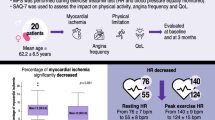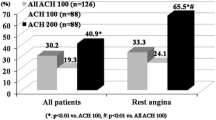Summary
The aim of this study was to investigate the antiischemic activity of propionyl carnitine (PC) in 18 informed, volunteer male patients, aged 37–70, suffering from a typical stable effort angina. The study design was randomized, balanced, crossover, and double blinded. The study lasted 75 days. In the first 15 days of washout the patients performed two maximal symptom-limited bicycle tests to verify the repeatability of the parameters examined. Then one group received PC for 30 days 500 mg three times a day, and the other group received placebo (PL) three times a day. At the end of 30 days the groups exchanged treatments. At the end of each period, 2 hours after the last oral administration, the patients performed a maximal symptom-limited bicycle exercise test with increased loads of 10 watts/min. No significant differences were observed between the two tests performed during the wash-out period, for a 1mm ST-segment depression time, for the time to the end of exercise, and for the rate x pressure product at the same experimental time. The oral administration of PC in coronary patients increased both the 1 mm ST-segment depression time and the time to the end of exercise. Furthermore, the drug reduced the ischemic depression of ST at maximal common work and at maximal work. After PC, the rate x pressure product was not significantly different in relation to placebo at submaximal and maximal exercise. Thus PC seems to have an antiischemiclike effect, probably related to its metabolic activity.
Similar content being viewed by others
References
Opie LH. Metabolism of the heart in health and disease. Part II.Am Heart J 1969;77:100–122.
Wood JM, Sordahl LA, Lewis RM, et al. Effect of chronic myocardial ischemia on the activity of carnitine palmityl-CoA transferase of isolated canine heart mitochondria.Circ Res 1973;32:340–347.
Shug AL, Shrago E, Bittar N, et al. Acyl-Coa inhibition of adenine nucleotide translocation in ischemic myocardium.Am J Physiol 1975;228:683–692.
Kjekshus JK, Mjos OD. Effects of free fatty acids on myocardial function and metabolism in the ischemic dog heart.J Clin Invest 1972;51:1767–1774.
Kurien VA, Yates PA, Oliver MF. Free fatty acids, heparin and arrhythmias during experimental myocardial infarction.Lancet 1969;2:185–193.
Liedtke AJ. Effect of excess free fatty acids on mechanical and metabolic function in normal and ischemic myocardium in swine.Circ Res 1978;43:652–659.
Oliver MF, Kurien VA, Greenwood TW. Relations between serum fatty acids and arrhythmias and death after acute myocardial infarction.Lancet 1968;1:710–717.
Shrago E, Shug AL, Sul H, et al. Control of energy production in myocardial ischemia.Circ Res 1976;38(Suppl I):75–79.
Idell-Wenger JA, Grottyonhann LW, Neely JR. Coenzvme A and carnitine distribution in normal and ischemic hearts.J Biol Chem 1978;253:4310–4318.
Shug AL, Shrago E, Bittar N, et al. Acyl-CoA inhibition of adenine nucleotide translocation in ischemic myocardium.Am J Physiol 1975;228:689–692.
Harris RA, Farmer B, Ozawa T. Inhibition of the mitochondrial adenine nucleotide transport system by oleyl-CoA.Arch Biochem Biophys 1972;150:199–209.
Neely JR, Morgan HE. Relationship between carbohydrate and lipid metabolism and the energy balance of heart muscle.Ann Rev Physiol 1974;36:413–422.
Devaux PF, Bienvenue A, Lauquin G, et al. Interaction between spin-labeled acyl-CoA and the mitochondrial diphosphate carrier.Biochemistry 1975;14:1272–1280.
Kotaka, K, Miyazaki Y, Ogawa K, et al. Protective effects of carnitine and its derivatives against free fatty acid induced mitochondrial dysfunction.J Appl Biochem 1981;3:328–336.
Schwartz A, Wood JM, Allen JC, et al. Biochemical and morphologic correlates of cardiac ischaemia.Am J Cardiol 1973;32:46–61.
Shug AL, Thomsen JH, Folts JD, et al. Changes in tissue levels of carnitine and other metabolites during myocardial ischaemia and anoxia.Arch Biochem Biophys 1978;187:25–33.
Suzuki Y, Kamikawa T, Yamazaki N. Protective effects of L-carnitine on ischaemic heart. In: Frenkel RA, McGarry JD, eds.,Carnitine biosynthesis, metabolism, and functions. New York: Academic Press, 1980:341–352.
Whitmer JT, Idell-Wenger JA, Rovetto MJ, et al. Control of fatty acid metabolism in ischemic and hypoxic heart.J Biol Chem 1978;253:4305–4309.
Liedtke AJ, Vary TC, Nells SH, et al. Properties of carnitine incorporation in working swine hearts. Effects of coronary flow, ischemia and excess fatty acids.Cire Res 1982;50:767–774.
Cherchi A, Fonzo R, Lai C, et al. Sull'azione antianginosa della carnitina.Boll Soc It Cardiol 1978;23:71–89.
Cherchi A, Lai C, Cioglia G, et al. Influence of carnitine on exercise tolerance test in effort angina pectoris.Proceedings of the IX Congress of Cardiology, Moscow, June 1982; 1:612.
Thomsen JH, Shug AL, Yap VU, et al. Improved pacing tolerance of the ischemic human myocardium after administration of carnitine.Am J Cardiol 1979;43:300–306.
Lai C, Cherchi A, Cioglia G, et al. Effetto della somministrazione orale di carnitina sul test di tolleranza allo sforzo.Proceedings of the XLIII Congresso Nazionale Soc It Cardiol, Roma 1982, abstract no. 159.
Cherchi A, Lai C, Angelino F, et al. Effects of L-carnitine on exercise tolerance in chronic stable angina: A multicenter double-blind, randomized, placebo controlled cross over study.Clin Pharm 1985;23:569–572.
Ferrari R, Cucchini F, Dilisa F, et al. The effect of L-carnitine (carnitene) on myocardial metabolism of patients with coronary artery disease.Clin Trial J 1984;21:40–58.
Kosolcharoen P, Nappi J, Peduzzi P, et al. Improved exercise tolerance after administration of carnitine.Curr Ther Res 1981;30:753–764.
Kamikawa T, Suzuki Y, Kobayashi A, et al. Effects of L-carnitine on exercise tolerance in patients with stable angina.Jpn Heart J 1984;25:587–597.
Kotaka K, Miyazaki Y, Ogawa K, et al. Reversal of ischemia-induced mitochondrial dysfunction after coronary reperfusion.J Mol Cell Cardiol 1982;14:223–231.
Cherchi A, Nissardi GP, Raffo M, et al. Electrocardiogramme et metabolisme an course de l'effort chez normaux et les cardiaques: Un test calibrè pour l'evaluation de l'insuffisance coronaire.IV Congr. Mundial de Cardiologia, Mexico 1962;II:224–335.
Cherchi A, Fonzo R, Bina M. Influence of nifedipine on the effort tolerance test in angina pectoris. Comparison with placebo and trinitroglycerine.Giorn It Cardiol 1974;4:1–10.
Rosseau MF, Hanet C, Pardonge-Lavenne E, et al. Changes in myocardial metabolism during therapy in patients with chronic stable angina: A comparison of long-term dosing with propranolo and nicardipine.Circulation 1986;73:1270–1280.
Sonnenblick EH, Ross J Jr, Braunwald E. Oxygen consumption of the heart: Newer concepts of its multifactorial determination.Am J Cardiol 1968;22:328–336.
Kitamura K, Jorgensen CR, Gobel FL, et al. Hemodynamic correlates of myocardial oxygen consumption during upright exercise.J appl Physiol 1972;32:516–522.
Nelson RR, Frederick GL, Jorgensen CR, et al. Hemodynamic predictors of myocardial oxygen consumption during static and dynamic exercise.Circulation 1974;50:1179–1189.
Joergensen CR, Wang K, Wang Y, et al. Effect of propranolol on myocardial oxygen consumption and its hemodynamic correlates during upright exercise.Circulation 1973;48: 1173–1182.
Holmberg S, Serzysko W, Varnauskas E. Coronary circulation during heavy exercise in control subjects and patients with coronary heart disease.Acta Med Scand 1971;190: 465–480.
Cherchi A, Fonzo R, Bina M. Influenza del test di tolleranza allo sforzo della trinitroglicerina, del propranololo, dell'amiodrone e del placebo nell'angina pectoris.Boll Soc It Cardiol 1974;19:1–13.
Pfisterer M, Glaus L, Burkazt F. Comparative effects of nitroglycerin, nifedipine and metropolol on regional left ventricular function in patients with one vessel coronary disease.Circulation 1983;67:291–301.
Engel HJ, Lichtlen PR., Beneficial enhancement of coronary blood flow by nifedipine. Comparison with nitroglycerin and beta blocking agents.Am J Med 1981;71:658–661.
Suzuki Y, Kamikawa T, Yamazaki N. Effect of L-carnitine on cardiac hemodynmics.Jpn Heart J 1981;22:219–225.
Crass MF III, McCaskill ES, Shipp JC. Glucose-free fatty acid interactions in the working heart.J Appl Physiol 1970;29:87–96.
Wood JM, Sordahl LA, Lewis RM, et al. Effect of chronic myocardial ischemia on the activity of carnitine palmityl coenzyme A transferase of isolate canine heart mitochondria.Circ Res 1973;32:340–348.
Brachfeld N, Ohtaka J, Klein I, et al. Substrate preference and metabolic activity of the aerobic and the hypoxic turtle heart.Circ Res 1972;31:453–461.
Bremer J, Woytezak AB. Factors controlling the rate of fatty acid betaoxidation in rat liver mitochondria.Biochim Biophys Acta 1972;280:515–524.
Author information
Authors and Affiliations
Rights and permissions
About this article
Cite this article
Cherchi, A., Lai, C., Onnis, E. et al. Propionyl carnitine in stable effort angina. Cardiovasc Drug Ther 4, 481–486 (1990). https://doi.org/10.1007/BF01857757
Issue Date:
DOI: https://doi.org/10.1007/BF01857757




